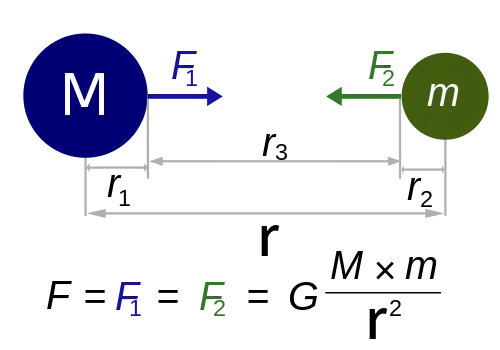
[Image1]
Introduction
Hey it's a me again @drifter1! In this article we will continue with Physics, and more specifically the branch of "Classical Mechanics". Today's article about Newton's Law of Gravitation marks the start of articles around the topic of Gravity. So, without further ado, let's dive straight into it!
Newton's Law of Gravitation
Newton's Universal law of gravitation states that:
Every particle in the Universe attracts every other particle with force that is proportional to the product of their masses and inversely proportional to the square of the distance between them.Mathematically this can be written as:

where:
- G, is the Universal Gravitational Constant, with current presision of 6.674 × 10-11 N m2/Kg2
- m1, m2, are the gravitational masses of the two gravitationally interacting particles
- d, is the distance between the centers of mass
Newton's Inspiration and Induction

[Image 2]
Sir Isaac Newton's inspiration for this Law was caused by the dropping of an apple from a tree, but surely not on his head as myth suggests. Newton wondered why the apple never dropped sideways or even upwards and was always directed perpendicular to the ground. Because the direction of falling was always towards the ground, Newton realized that the Earth itself must be responsible for the apple's downward motion.
He theorized that the force must be proportional to the masses of the two objects involved, and used his previous intuition about the inverse-square relationship of the force between the earth and the moon, and thus formulated the general physical law by induction. Although Newton verified the Law experimentally he could only calculate the relative gravitational force in comparison to another force. Henry Cavendish was the one to verify the gravitational constant and give the Law of Universal Gravitation its final algebraic form.
Meaning of the Gravitation Constant G
The units of G are obtained by considering masses in kilograms, distance in meters, and force in Newtons, in the Law of Gravity:

Two 1 Kg masses that are separated by 1m experience a gravitational attraction thats equal in value to G and so 6.674 × 10-11 N.
This force is infinitesimal, but consistent. Large objects like mountatins exert gravitational force on us, but also smaller ones like the pizza we like to eat when watching movies. Even our body weight is the force of attraction of the entire Earth on us, which has a mass of about 6 × 1024 Kg. We will get more into that, next time!
Gravitational Pull of Pizza

[Image 3]
Because I mentioned pizza, let's calculate the gravitational force that pizza acts upon an average male. Let's suppose that a medium pizza is 600 g, and is split into 4 equal slices of 150 g. Let's also consider the average male to be around 80 Kg. What's the gravitational pull of the whole pizza and each piece, if the pizza is about 1 m away of the male?
Solution
Using Newton's Law of Gravitation and simply filling in the corresponding values, for each pizza-slice we get:

Thus, the whole pizza applies a force equal to:

That's not much gravitational force, but quite tasty... 😅
RESOURCES:
References
- https://phys.libretexts.org/Bookshelves/Astronomy__Cosmology/Book%3A_Celestial_Mechanics_(Tatum)/05%3A_Gravitational_Field_and_Potential/5.03%3A_Newton's_Law_of_Gravitation
- https://courses.lumenlearning.com/boundless-physics/chapter/newtons-law-of-universal-gravitation/
- https://openstax.org/books/college-physics/pages/6-5-newtons-universal-law-of-gravitation
- https://www.khanacademy.org/science/high-school-physics/uniform-circular-motion-and-gravitation-2/newtons-law-of-gravitation/a/newtons-law-of-gravitation-ap1
Images
Mathematical equations used in this article, where made using quicklatex.
Previous articles of the series
Rectlinear motion
- Velocity and acceleration in a rectlinear motion -> velocity, acceleration and averages of those
- Rectlinear motion with constant acceleration and free falling -> const acceleration motion and free fall
- Rectlinear motion with variable acceleration and velocity relativity -> integrations to calculate pos and velocity, relative velocity
- Rectlinear motion exercises -> examples and tasks in rectlinear motion
Plane motion
- Position, velocity and acceleration vectors in a plane motion -> position, velocity and acceleration in plane motion
- Projectile motion as a plane motion -> missile/bullet motion as a plane motion
- Smooth Circular motion -> smooth circular motion theory
- Plane motion exercises -> examples and tasks in plane motions
Newton's laws and Applications
- Force and Newton's first law -> force, 1st law
- Mass and Newton's second law -> mass, 2nd law
- Newton's 3rd law and mass vs weight -> mass vs weight, 3rd law, friction
- Applying Newton's Laws -> free-body diagram, point equilibrium and 2nd law applications
- Contact forces and friction -> contact force, friction
- Dynamics of Circular motion -> circular motion dynamics, applications
- Object equilibrium and 2nd law application examples -> examples of object equilibrium and 2nd law applications
- Contact force and friction examples -> exercises in force and friction
- Circular dynamic and vertical circle motion examples -> exercises in circular dynamics
- Advanced Newton law examples -> advanced (more difficult) exercises
Work and Energy
- Work and Kinetic Energy -> Definition of Work, Work by a constant and variable Force, Work and Kinetic Energy, Power, Exercises
- Conservative and Non-Conservative Forces -> Conservation of Energy, Conservative and Non-Conservative Forces and Fields, Calculations and Exercises
- Potential and Mechanical Energy -> Gravitational and Elastic Potential Energy, Conservation of Mechanical Energy, Problem Solving Strategy & Tips
- Force and Potential Energy -> Force as Energy Derivative (1-dim) and Gradient (3-dim)
- Potential Energy Diagrams -> Energy Diagram Interpretation, Steps and Example
- Internal Energy and Work -> Internal Energy, Internal Work
Momentum and Impulse
- Conservation of Momentum -> Momentum, Conservation of Momentum
- Elastic and Inelastic Collisions -> Collision, Elastic Collision, Inelastic Collision
- Collision Examples -> Various Elastic and Inelastic Collision Examples
- Impulse -> Impulse with Example
- Motion of the Center of Mass -> Center of Mass, Motion analysis with examples
- Explaining the Physics behind Rocket Propulsion -> Required Background, Rocket Propulsion Analysis
Angular Motion
- Angular motion basics -> Angular position, velocity and acceleration
- Rotation with constant angular acceleration -> Constant angular acceleration, Example
- Rotational Kinetic Energy & Moment of Inertia -> Rotational kinetic energy, Moment of Inertia
- Parallel Axis Theorem -> Parallel axis theorem with example
- Torque and Angular Acceleration -> Torque, Relation to Angular Acceleration, Example
- Rotation about a moving axis (Rolling motion) -> Fixed and moving axis rotation
- Work and Power in Angular Motion -> Work, Work-Energy Theorem, Power
- Angular Momentum -> Angular Momentum and its conservation
- Explaining the Physics behind Mechanical Gyroscopes -> What they are, History, How they work (Precession, Mathematical Analysis) Difference to Accelerometers
- Exercises around Angular motion -> Angular motion examples
Equilibrium and Elasticity
- Rigid Body Equilibrium -> Equilibrium Conditions of Rigid Bodies, Center of Gravity, Solving Equilibrium Problems
- Force Couple System -> Force Couple System, Example
- Tensile Stress and Strain -> Tensile Stress, Tensile Strain, Young's Modulus, Poisson's Ratio
- Volumetric Stress and Strain -> Volumetric Stress, Volumetric Strain, Bulk's Modulus of Elasticity, Compressibility
- Cross-Sectional Stress and Strain -> Shear Stress, Shear Strain, Shear Modulus
- Elasticity and Plasticity of Common Materials -> Elasticity, Plasticity, Stress-Strain Diagram, Fracture, Common Materials
- Rigid Body Equilibrium Exercises -> Center of Gravity Calculation, Equilibrium Problems
- Exercises on Elasticity and Plasticity -> Young Modulus, Bulk Modulus and Shear Modulus Examples
Final words | Next up
And this is actually it for today's post!Next time we will talk about Weight and Gravitational Fields
See ya!



